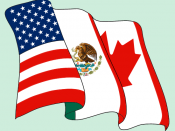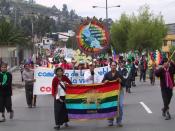Social Change and Development
Sociology 336
11-13-03
Free Trade Area of the Americas (FTAA)
Free Trade Area of the Americas (FTAA) is an extension of the North American Free Trade Agreement (NAFTA). The FTAA follows a similar model that was developed by NAFTA. FTAA has nine groups that correspond to NAFTA's chapters. The FTAA's nine groups cover the following topics: agriculture, competition policy, dispute settlement, government procurement, intellectual property rights, investment, market access, services, subsidies, and anti-dumping. FTAA started when U.S officials organized a Summit of the Americas; this conference laid the foundation for hemisphere-wide free trade. Thirty-four nations set up the Trade Advisory Committee, and negotiators of this committee meet every month. The FTAA has not incorporated citizens' input in the negotiation process despite the persistent calls for an open and democratic development of trade policy. On the other hand due to this and lack of publicity most people are unaware of the FTAA and what it represents.
Without citizen interference, corporate representatives are able to advise the negotiators during the rule writing process, which allows for greater corporate control. The rules developed by the FTAA neglect social services and prevent the government from regulating health, labor and the environment, while encouraging deregulation and privatizations. The FTAA claims that these regulations would create a "barrier to trade."
There is a generalized fear that the FTAA will amplify the negative effects that were created by NAFTA. An estimated 766,000 people lost their jobs in the U.S. when companies relocated to Mexico. NAFTA caused U.S. citizens to suffer as well as Mexico with this transition. Mexican workers are taken advantage of receiving less wages and fewer benefits. Corporations get by saying that the workers are paid the local minimum wage, but minimum wage is set at poverty level. The Mexican peso...


